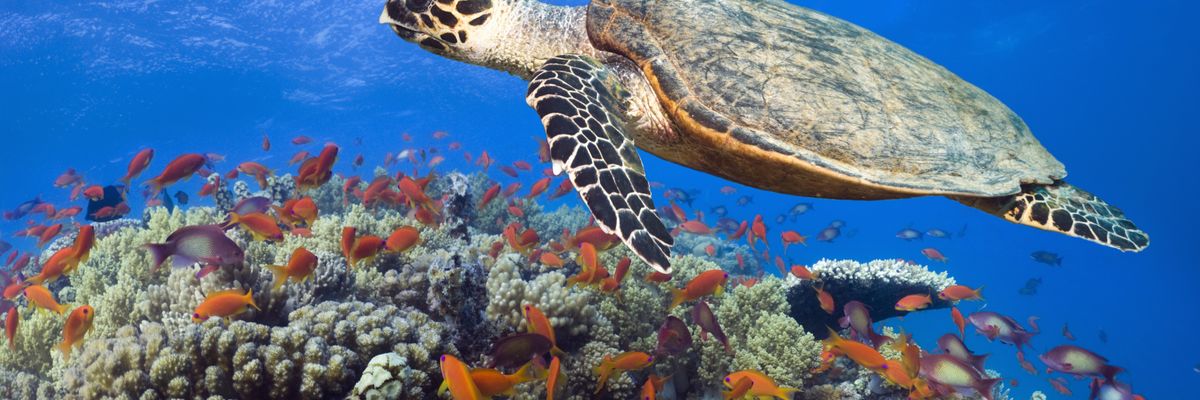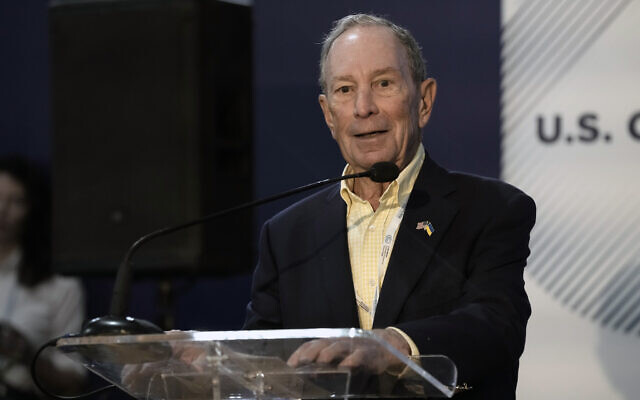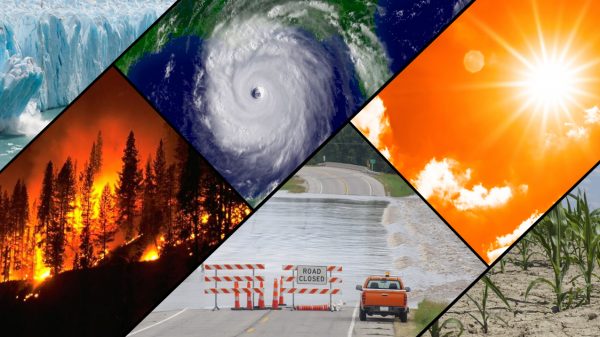UN members agree to protect marine life in high seas for first time: ‘The ocean is not a limitless resource’
March 5, 2023

Sandbar sharks swim next to a person snorkeling in the Mediterranean Sea off the coast of Hadera, Israel, Monday, Nov. 21, 2022. For the first time, United Nations members have agreed on a unified treaty on Saturday, March 4, 2023, to protect biodiversity in the high seas—nearly half the planet’s surface.
For the first time, United Nations members have agreed on a unified treaty to protect biodiversity in the high seas – representing a turning point for vast stretches of the planet where conservation has previously been hampered by a confusing patchwork of laws.
The U.N. Convention on the Law of the Sea came into force in 1994, before marine biodiversity was a well-established concept. The treaty agreement concluded two weeks of talks in New York.
An updated framework to protect marine life in the regions outside national boundary waters, known as the high seas, had been in discussions for more than 20 years, but previous efforts to reach an agreement had repeatedly stalled. The unified agreement treaty, which applies to nearly half the planet’s surface, was reached late Saturday.
“We only really have two major global commons — the atmosphere and the oceans,” said Georgetown marine biologist Rebecca Helm. While the oceans may draw less attention, “protecting this half of earth’s surface is absolutely critical to the health of our planet.”
Nichola Clark, an oceans expert at the Pew Charitable Trusts who observed the talks in New York, called the long-awaited treaty text “a once-in-a-generation opportunity to protect the oceans — a major win for biodiversity.”
The treaty will create a new body to manage conservation of ocean life and establish marine protected areas in the high seas. And Clark said that’s critical to achieve the U.N. Biodiversity Conference’s recent pledge to protect 30% of the planet’s waters, as well as its land, for conservation.
Treaty negotiations initially were anticipated to conclude Friday, but stretched through the night and deep into Saturday. The crafting of the treaty, which at times looked in jeopardy, represents “a historic and overwhelming success for international marine protection,” said Steffi Lemke, Germany’s environment minister.
“For the first time, we are getting a binding agreement for the high seas, which until now have hardly been protected,” Lemke said. “Comprehensive protection of endangered species and habitats is now finally possible on more than 40% of the Earth’s surface.”
The treaty also establishes ground rules for conducting environmental impact assessments for commercial activities in the oceans.
“It means all activities planned for the high seas need to be looked at, though not all will go through a full assessment,” said Jessica Battle, an oceans governance expert at the Worldwide Fund for Nature.
Several marine species — including dolphins, whales, sea turtles and many fish — make long annual migrations, crossing national borders and the high seas. Efforts to protect them, along with human communities that rely on fishing or tourism related to marine life, have long proven difficult for international governing bodies.
“This treaty will help to knit together the different regional treaties to be able to address threats and concerns across species’ ranges,” Battle said.
That protection also helps coastal biodiversity and economies, said Gladys Martínez de Lemos, executive director of the nonprofit Interamerican Association for Environmental Defense focusing on environmental issues across Latin America.
“Governments have taken an important step that strengthens the legal protection of two-thirds of the ocean and with it marine biodiversity and the livelihoods of coastal communities,” she said.
The question now is how well the ambitious treaty will be implemented.
Formal adoption also remains outstanding, with numerous conservationists and environmental groups vowing to watch closely.
The high seas have long suffered exploitation due to commercial fishing and mining, as well as pollution from chemicals and plastics. The new agreement is about “acknowledging that the ocean is not a limitless resource, and it requires global cooperation to use the ocean sustainably,” Rutgers University biologist Malin Pinsky said.
Associated Press writer Frank Jordans contributed to this report from Berlin
"This is a historic day for conservation and a sign that in a divided world, protecting nature and people can triumph over geopolitics," said Greenpeace in response to an agreement to protect world's marine biodiversity.

Hawksbill turtle swimming over coral reef.
(Photo by Georgette Douwma / iStock via Gettty Images)
JON QUEALLY
Mar 05, 2023
Ocean conservationists expressed elation late Saturday after it was announced—following nearly two decades of consideration and effort—that delegates from around the world had agreed to language for a far-reaching global treaty aimed at protecting the biodiversity on the high seas and in the deep oceans of the world.
"This is a historic day for conservation and a sign that in a divided world, protecting nature and people can triumph over geopolitics," declared Dr. Laura Meller, the oceans campaigner for Greenpeace Nordic.
"We praise countries for seeking compromises, putting aside differences, and delivering a Treaty that will let us protect the oceans, build our resilience to climate change and safeguard the lives and livelihoods of billions of people," Meller added.
The final text of the Global Ocean Treaty, formally referred to as the Biodiversity Beyond National Jurisdiction treaty (BBNJ), was reached after a two-week round of talks that concluded with a 48-hour marathon push between delegations at the United Nations headquarters in New York.
"The High Seas Treaty opens the path for humankind to finally provide protection to marine life across our one ocean."
"This is huge," said Greenpeace in a social media post, calling the agreement "the biggest conservation victory ever!"
Rena Lee of Singapore, the U.N Ambassador for Oceans and president of the conference hosting the talks, received a standing ovation after announcing a final deal had been reached. "The shipped has reached the shore," Lee told the conference.
"Following a two-week-long rollercoaster ride of negotiations and super-hero efforts in the last 48 hours, governments reached agreement on key issues that will advance protection and better management of marine biodiversity in the High Seas," said Rebecca Hubbard, director of the High Seas Alliance, a coalition of over 40 ocean-focused NGOs that also includes the International Union for the Conservation of Nature (IUCN).
Minna Epps, director of the Global Marine and Polar Programme at the IUCN, said the agreement represents a new opportunity.
"The High Seas Treaty opens the path for humankind to finally provide protection to marine life across our one ocean," Epps said in a statement. "Its adoption closes essential gaps in international law and offers a framework for governments to work together to protect global ocean health, climate resilience, and the socioeconomic wellbeing and food security of billions of people."
Protecting the world's high seas, which refers to areas of the oceans outside the jurisdiction of any country, is part of the larger push to protect planetary biodiversity and seen as key if nations want to keep their commitment to the UN-brokered Kunming-Montreal Global Biodiversity Framework—also known as the known as the 30x30 pledge—that aims protect 30 percent of the world's natural habitat by 2030.
"With currently just over 1% of the High Seas protected," said the High Seas Alliance in a statement, "the new Treaty will provide a pathway to establish marine protected areas in these waters." The group said the treaty will make acheiving the goals of the Kunming-Montreal agreement possible, but that "time is of the essence" for the world's biodiversity.
"The new Treaty will bring ocean governance into the 21st century," said the group, "including establishing modern requirements to assess and manage planned human activities that would affect marine life in the High Seas as well as ensuring greater transparency. This will greatly strengthen the effective area-based management of fishing, shipping, and other activities that have contributed to the overall decline in ocean health."
According to Greenpeace's assessment of the talks:
The High Ambition Coalition, which includes the EU, US and UK, and China were key players in brokering the deal. Both showed willingness to compromise in the final days of talks, and built coalitions instead of sowing division. Small Island States have shown leadership throughout the process, and the G77 group led the way in ensuring the Treaty can be put into practice in a fair and equitable way.
The fair sharing of monetary benefits from Marine Genetic Resources was a key sticking point. This was only resolved on the final day of talks. The section of the Treaty on Marine Protected Areas does away with broken consensus-based decision making which has failed to protect the oceans through existing regional bodies like the Antarctic Ocean Commission. While there are still major issues in the text, it is a workable Treaty that is a starting point for protecting 30% of the world’s oceans.
The group said it is now urgent for governments around the world to take the final step of ratifying the treaty.
"We can now finally move from talk to real change at sea. Countries must formally adopt the Treaty and ratify it as quickly as possible to bring it into force, and then deliver the fully protected ocean sanctuaries our planet needs," Meller said. "The clock is still ticking to deliver 30×30. We have half a decade left, and we can't be complacent."
Our work is licensed under Creative Commons (CC BY-NC-ND 3.0). Feel free to republish and share widely.
JON QUEALLYis managing editor of Common Dreams.












